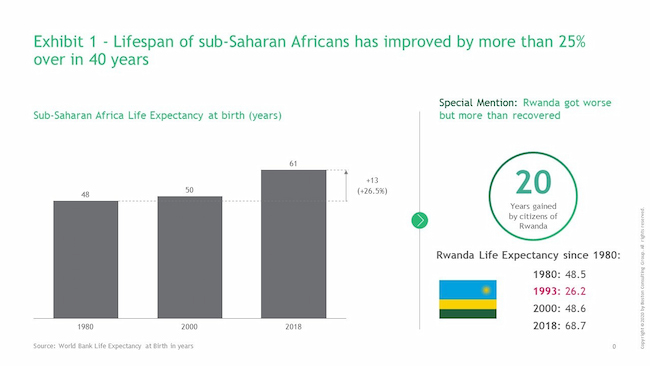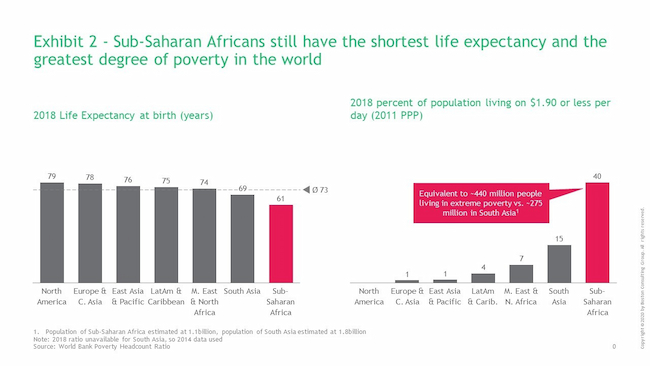I was born in Nigeria in the early 1980s. Based on forecasts at the time, I should be starting the final decade of my life now (see Exhibit 1).
But my odds have improved quite a bit. Indeed, it is a testament to the advances over these past 40 years in healthcare and standards of living – in the overall quality of life for at least some people – that the average life expectancy for a person born today in sub-Saharan Africa (SSA) has increased by ten years.
In some countries, like Rwanda, which was beset by a devastating civil war in the 1990s, the life expectancy gains are even more dramatic. Part of the reason for the rise in average life expectancy is the fall in early childhood mortality. Death rates among SSA children under 5 have declined to fewer than 80 per 1000 live births in 2018 from more than double that figure in 1990. This progress is laudable,

But despite these gains, there is much further to go. Even with the advances in life expectancy, sub-Saharan Africa lags much of the rest of the world in this regard (see Exhibit 2). In fact, the life expectancy in Africa’s most populous country, Nigeria, is only 55 years. And perhaps more disconcerting is the region’s alarming poverty rate.
About 40% of sub-Saharan Africa, or over 400 million people, live on less than $1.90 a day, defined as the extreme-poverty line. That is more than double the poverty rate in South Asia, another region struggling with widespread destitution. Moreover, the Covid-19 virus may set back the region even more. Recent separate reports from the World Health Organization and the World Bank estimate that globally the number of preventable child deaths and poverty rates will regress to previous high levels before the pandemic is over, particularly in countries already struggling the most. We already had a long journey ahead of us and now the distance has been stretched.

Clearly, the emergence of sub-Saharan Africa as an economic success offering a decent quality of life and a better future for its population is at best in its very infantile stages. In virtually each category of the 17 United Nations Sustainable Development Goals (SDGs) – covering healthcare, hunger, education, jobs, fair wages, economic growth and the environment, among other critical dimensions – sub-Saharan Africa trails well behind the rest of the world.
Perhaps the most problematic issue is that while we have a long distance to travel, we have to get there at a record pace. The UN has set a target of 2030 to reach the SDG’s goals and in effect eliminate the developmental obstacles to growth and minimum livelihoods that hold back SSA and other countries around the world. For SSA, that is an ambitious deadline.
To just take one example, the ratio of people living in extreme poverty in sub-Saharan Africa dropped from around 50% a decade ago to today’s 40%. Going from 40 percent to zero in the next nine years would require a development campaign far exceeding anything tried before in these countries.
Yet, as difficult as that sounds, we can at least make significant progress if we avoid wasted efforts and inefficiencies. We must optimize our development efforts for faster impact. We must optimize for speed.
Over a series of posts, I will explore the critical facets of development activities in the region that must be emphasized and improved upon to achieve quicker and more permanent progress.
Initially, I will focus on three areas that can be addressed immediately and produce results in a relatively short time: We must gather more and better data and utilize it more effectively; we must increasingly adjust the developmental techniques we employ to ensure they sufficiently address local concerns and issues while taking advantage of existing best practices, even from other disciplines; and we must enlarge the tent to bring a wider and more diverse group of people into the design and implementation process.
Looking at these three areas more closely, there are significant gaps between how we view them today and how we should both enhance our understanding of them and improve how we use them to make real developmental gains:
Data: Good data about the SSA region is essential. It would allow us to fully understand current conditions and livelihood challenges, compare ourselves against other regions that are attempting to be innovative in solving the same problems, and measure our progress in granular intervals against goals – including the UN SDGs – so that we can take corrective action quickly where needed to keep ourselves on track.
Unfortunately, sub-Saharan Africa is data challenged and has been so for a while. But if we try to build our data aggregation capabilities slowly, following the path that regions with inherently more data have taken, we will not be able to move as fast as we must. Therefore, we must identify and implement pragmatic approaches to dramatically improve our data gathering procedures and methods.
READ ALSO: Five Startups From Africa Compete For $500,000 In World’s Largest Emerging Markets Competition
Techniques: In attempting to solve specific development challenges we often make the mistake of adopting tried and tested technical approaches that perhaps have worked in other places but are insufficiently tailored to the specific needs of the sub-Saharan region. As a result, we forfeit the opportunity to consider methods and strategies that are aligned with unique regional needs.
For instance, behavioral techniques can encourage desirable actions by sub-Saharan individuals and groups, which in turn can help in local development. Or digital solutions can leverage software to make a development program more cost-effective. For instance, advancing the use of telemedicine so physicians from outside SSA can efficiently and inexpensively supplement local medical services.
These are just two possibilities and the more we think about innovative techniques well suited to the region, the better we will get at designing and implementing them.
People: Although there appears to be a push to increasingly widen the participation of African people in the campaigns to solve Africa’s problems, I believe that we are still ignoring many potential beneficiaries. In other words, even in our attempts to enlarge the tent, we still fail to address the needs of key stakeholders that are pivotal for the success of SSA development efforts; among them, women, young people, the bottom of the economic pyramid, the private sector and small businesses.
Perhaps a more provocative perspective on this is that we must expand the tent of people taking part in designing developmental solutions and overcome our challenges with the help of beneficiaries – rather than trying to provide answers to or for the beneficiaries.
So, how should we approach development in sub-Saharan Africa during this decade? Africans favor the expression, ‘If you want to go quickly, go alone. If you want to go far, go together.’ I would add that we must actually go further than we had thought pre-COVID, and we must also go fast.
Over the coming weeks, I will share my thoughts about some of the things we can do to address the three areas I mentioned that must be immediately analyzed, improved upon and tailored for a sub-Saharan solution. I hope we can debate these issues and that collectively we can produce an exhaustive and workable series of steps to begin a viable developmental journey for SSA.
So, what do you think? Do you agree that we have a long way to go despite the progress? Is there a case for maintaining the status quo and continuing to attempt development across the region as we have before? In addition to Data, Techniques, and People, are there other aspects of development designs that we should be considering and fixing?
In my view, the gap between where we are today and where we must get to by 2030 is far. I look forward to exploring together how we achieve these bold goals quickly.











